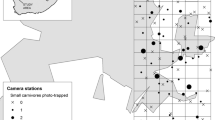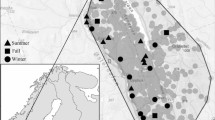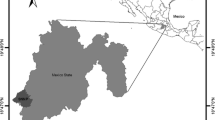Abstract.
We examined the relative roles of dominance in agonistic interactions and energetic constraints related to body size in determining local abundances of coyotes (Canis latrans, 8–20 kg), gray foxes (Urocyon cinereoargenteus, 3–5 kg) and bobcats (Felis rufus, 5–15 kg) at three study sites (hereafter referred to as NP, CP, and SP) in the Santa Monica Mountains of California. We hypothesized that the largest and behaviorally dominant species, the coyote, would exploit a wider range of resources (i.e., a higher number of habitat and/or food types) and, consequently, would occur in higher density than the other two carnivores. We evaluated our hypotheses by quantifying their diets, food overlap, habitat-specific abundances, as well as their overall relative abundance at the three study sites. We identified behavioral dominance of coyotes over foxes and bobcats in Santa Monica because 7 of 12 recorded gray fox deaths and 2 of 5 recorded bobcat deaths were due to coyote predation, and no coyotes died as a result of their interactions with bobcats or foxes. Coyotes and bobcats were present in a variety of habitats types (8 out of 9), including both open and brushy habitats, whereas gray foxes were chiefly restricted to brushy habitats. There was a negative relationship between the abundances of coyotes and gray foxes (P=0.020) across habitats, suggesting that foxes avoided habitats of high coyote predation risk. Coyote abundance was low in NP, high in CP, and intermediate in SP. Bobcat abundance changed little across study sites, and gray foxes were very abundant in NP, absent in CP, and scarce in SP; this suggests a negative relationship between coyote and fox abundances across study sites, as well. Bobcats were solely carnivorous, relying on small mammals (lagomorphs and rodents) throughout the year and at all three sites. Coyotes and gray foxes also relied on small mammals year-round at all sites, though they also ate significant amounts of fruit. Though there were strong overall interspecific differences in food habits of carnivores (P<0.0001), average seasonal food overlaps were high due to the importance of small mammals in all carnivore diets [bobcat-gray fox: 0.79±0.09 (SD), n=4; bobcat-coyote: 0.69±0.16, n=6; coyote-gray fox: 0.52±0.05, n=4]. As hypothesized, coyotes used more food types and more habitat types than did bobcats and gray foxes and, overall, coyotes were the most abundant of the three species and ranged more widely than did gray foxes. We propose that coyotes limit the number and distribution of gray foxes in Santa Monica Mountains, and that those two carnivores exemplified a case in which the relationship between their body size and local abundance is governed by competitive dominance of the largest species rather than by energetic equivalences. However, in the case of the intermediate-sized bobcat no such a pattern emerged, likely due to rarity or inconsistency of agonistic interactions and/or behavioral avoidance of encounters by subordinate species.
Similar content being viewed by others
Author information
Authors and Affiliations
Additional information
Electronic Publication
Rights and permissions
About this article
Cite this article
Fedriani, J., Fuller, T., Sauvajot, R. et al. Competition and intraguild predation among three sympatric carnivores. Oecologia 125, 258–270 (2000). https://doi.org/10.1007/s004420000448
Received:
Accepted:
Published:
Issue Date:
DOI: https://doi.org/10.1007/s004420000448




